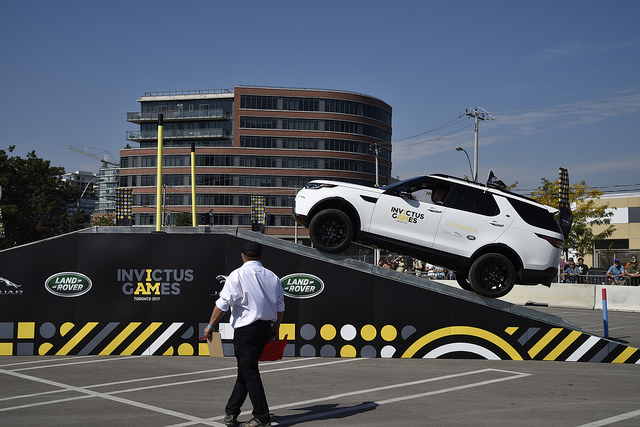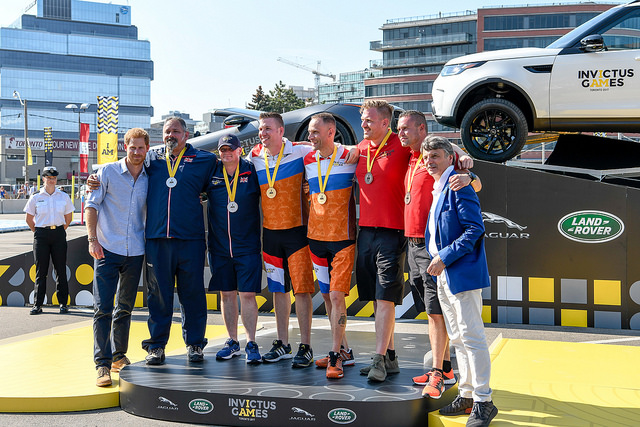
The intense look on Corporal Glen Jobson’s face said it all: driving the Jaguar Land Rover off-road course requires complete concentration and cool. Like most competitors in the Jaguar Land Rover Driving Challenge, Glen and teammate Corporal Pierre Hansen of Denmark had never tried a man-made course like this before.
“We saw videos from Orlando [2016 Invictus Games], but it looks a little more difficult than I expected, here in Toronto,” said Glen before he sat behind the wheel.
Two separate driving courses were put to the test in Toronto’s historic Distillery District today. The first was a Land Rover off-road-style course, with four distinctly different elevated features, which are to be conquered in under eight minutes. The waffler, for instance, simulates deep mud with potholes, while the waggler — a giant ramp with additional ramps on top — can be likened to driving over two awkwardly placed boulders, allowing only one or two wheels of the vehicle to touch the peak of the boulder’s teetering point. Each driver has a teammate and cameras to help navigate the course, while some vehicles are equipped with hand controls to enable competitors with physical disabilities to take part.
Supporter Brett Bramley, who was in the stands cheering for his sister Julie Bramley from Team New Zealand,said it’s a great spectator event to see how the different teams navigate the same obstacle. “Everyone has a different approach even when they are stuck on the same thing, so it’s awesome to watch all the different ways to do it.”
The Jaguar racing course, taking place on the adjacent parking lot, was a challenge of speed. Teams zip through a system of sophisticated gates —flashing green lights indicate the immediate path and blue lights indicate the next turn. The hairpin course differs each round, so communication between teammates is key.
Indoor rower Martin Arbon of Denmark, who was among the crowd supporting his Danish teammates, described the feeling of being in the moment during these types of sports. Intense activities like these force a person’s worries to take a backseat: “It’s spiritual and mental cleansing,” said Martin. “Like with rowing, you can put your mind on standby.”
For Sergeant Kristjan Roivas of Estonia, the 2017 Invictus Games courses are a new challenge compared to his driving experience at the Orlando Invictus Games in 2016. Not only is the terrain different, but last year Prince Harry rode in the back seat as he navigated Team Estonia through the off-road challenge, where he earned a silver medal.
Said Kristjan: “Everybody is in the [same boat], because nobody has this kind of course at home, so I really, really like it.”
To cap off the event, His Royal Highness Prince Harry enthusiastically jumped into the passenger seat of a Jaguar convertible, with German driving competitor Dennis Siesing providing an exhilarating ride through the gates. When the car stopped, Prince Harry gave a cheer, waving Kurt, Dennis’ stuffed bear, good luck charm and Team Germany mascot, in the air.
Said Dennis with a wide smile: “[Prince Harry] kept saying ‘It’s ok. Go faster, go faster’.”



